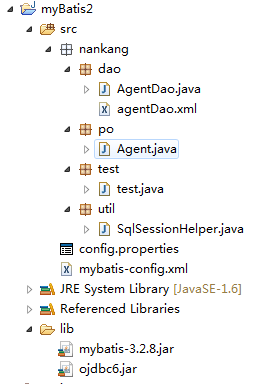目录
数据库的经典操作:增删改查。
在这一章我们主要说明一下简单的查询和增删改,并且对程序接口做了一些调整,以及对一些问题进行了解答。
1、调整后的结构图:

2、连接数据库文件配置分离:
一般的程序都会把连接数据库的配置单独放在.properties 文件中,然后在XML文件中引用,示例如下:
config.properties:
driver=oracle.jdbc.OracleDriver url=jdbc:oracle:thin:@127.0.0.1:1521:orcl username=phonesurvey password=world
mybatis-config.xml:
<?xml version="1.0" encoding="UTF-8"?>
<!DOCTYPE configuration PUBLIC "-//mybatis.org//DTD Config 3.0//EN"
"http://mybatis.org/dtd/mybatis-3-config.dtd">
<configuration>
<properties resource="config.properties" />
<environments default="development">
<environment id="development">
<transactionManager type="JDBC" />
<dataSource type="POOLED">
<property name="driver" value="${driver}"/>
<property name="url" value="${url}"/>
<property name="username" value="${username}"/>
<property name="password" value="${password}"/>
</dataSource>
</environment>
</environments>
<mappers>
<mapper resource="nankang/dao/agentDao.xml" />
</mappers>
</configuration>
3、SqlSession分离:
SqlSeesion单独做成工具类,以便调用,示例如下:
SqlSessionHelper:
package nankang.util;
import java.io.InputStream;
import org.apache.ibatis.io.Resources;
import org.apache.ibatis.session.SqlSessionFactory;
import org.apache.ibatis.session.SqlSessionFactoryBuilder;
public class SqlSessionHelper {
public static SqlSessionFactory getSessionFactory(){
SqlSessionFactory sessionFactory = null;
String resource= "mybatis-config.xml";
try{
InputStream inputStream = Resources.getResourceAsStream(resource);
//Reader reader = Resources.getResourceAsReader(resource);
sessionFactory = new SqlSessionFactoryBuilder().build(inputStream);
}catch(Exception ex){
ex.printStackTrace();
}
return sessionFactory;
}
}
SqlSessionFactory创建时,根据Reader和InputStream都可以。
4、XML文件添加内容:
agentDao.xml:
<?xml version="1.0" encoding="UTF-8"?>
<!DOCTYPE mapper PUBLIC "-//mybatis.org//DTD Mapper 3.0//EN"
"http://mybatis.org/dtd/mybatis-3-mapper.dtd">
<mapper namespace="nankang.dao.AgentDao">
<!-- 根据Id查询 -->
<select id="selectAgentById" parameterType="string" resultType="nankang.po.Agent">
select * from Agent where AgentId=#{id}
</select>
<!-- 添加 -->
<insert id="insertAgent" parameterType="nankang.po.Agent">
insert into Agent(agentId, companyCode, LoginName, AgentPwd, AgentCode, Name, status,sysFlag)
values(#{agentId},'SHNK',#{loginName},'D41D8CD98F00B204E9800998ECF8427E',#{agentCode},#{name},1,1)
</insert>
<!-- 删除 -->
<delete id="deleteAgent" parameterType="string">
delete from Agent where agentid=#{id}
</delete>
<!-- 修改 -->
<update id="updateAgent" parameterType="nankang.po.Agent">
update agent set name=#{name} where agentid=#{agentId}
</update>
<!-- 查询所有 -->
<select id="selectAllAgent" resultType="nankang.po.Agent">
select * from Agent
</select>
<!-- 查询所有无返回对象 -->
<select id="selectAllAgent2" resultType="hashmap">
select * from Agent
</select>
</mapper>
AgentDao.java:
package nankang.dao;
import java.util.List;
import java.util.Map;
import nankang.po.Agent;
import org.apache.ibatis.annotations.Select;
public interface AgentDao {
//根据Id查询
public Agent selectAgentById(String Id);
//根据名称查询
@Select("select * from Agent where name=#{name}")
public Agent selectAgentByName(String name);
//添加
public int insertAgent(Agent agent);
//删除
public int deleteAgent(String id);
//修改
public int updateAgent(Agent agent);
//查询所有的
public List<Agent> selectAllAgent();
public List<Map<String, Object>> selectAllAgent2();
}
1、XML文件中的语句,可以直接写在接口文件中,如:根据名称查询;
2、其他参考示例。
几个问题说明:
1)如何查询数据集合?
使用ResultType设置,返回用List<T>即可
2)查询一条数据,如果为空,怎么判断?
如果没有查询到数据,返回为NULL,进行空对象判断即可
3)查询所有的集合,不放在构建对象的List中:
resultType=map,返回类型 List<Map<String,Object>>,字段为空则不展示在Map中
4)如何实现事务:
SqlSession:commit,rollback,close
5、测试
package nankang.test;
import java.util.List;
import java.util.Map;
import nankang.dao.AgentDao;
import nankang.util.SqlSessionHelper;
import org.apache.ibatis.session.SqlSession;
public class test {
/**
* @param args
*/
public static void main(String[] args) {
SqlSession sqlSession = SqlSessionHelper.getSessionFactory().openSession();
try{
AgentDao agentMapper = sqlSession.getMapper(AgentDao.class);
//根据Id查询
// Agent agent = agentMapper.selectAgentById("SHNKAG00000000051");
// if(null != agent){
// System.out.println(agent.getName());
// }else{
// System.out.println("不存在该用户");
// }
// agent = agentMapper.selectAgentByName("1001");
// System.out.println(agent.getAgentId());
//查询所有
List<Map<String, Object>> agentList = agentMapper.selectAllAgent2();
System.out.println(agentList.size());
//添加
// Format format = new SimpleDateFormat("00yyyyMMddhhmmss");
// Calendar calendar = Calendar.getInstance();
// String dateStr = format.format(calendar.getTime());
// Agent agent = new Agent();
// agent.setAgentId(dateStr);
// agent.setLoginName("1111");
// agent.setAgentCode("aaaa");
// agent.setName("aaaa");
// int num = agentMapper.insertAgent(agent);
// System.out.println(num);
//删除
// int num = agentMapper.deleteAgent("0020150226093127");
// System.out.println(num);
//更新
// Agent agent = new Agent();
// agent.setAgentId("0020150226010005");
// agent.setName("Test");
// int num = agentMapper.updateAgent(agent);
// System.out.println(num);
//增删改,提交
sqlSession.commit();
System.out.println("完成");
}catch(Exception ex){
sqlSession.rollback();
System.out.println(ex.getMessage());
}finally{
sqlSession.close();
}
}
}
这边需要注意的是:SqlSession一定要close
